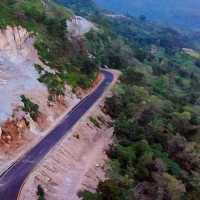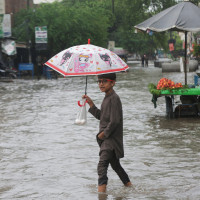- Wednesday, 16 July 2025
Red-billed Blue Magpie: Conservation Concerns
Shivpuri National Park, situated in a transitional zone between sub-tropical and temperate climates, is renowned for its avian diversity, harbouring 177 bird species, including nine threatened ones, among the 892 species recorded in Nepal. Notably, the Red-billed Blue Magpie, known as "Shyalpothari Lampuchare" in Nepali, resides here. Distinguished by its striking crimson bill and vibrant plumage, this intelligent and sociable bird is akin to crows in terms of interaction but lacks the qualities of a parrot. Nevertheless, it displays mirror self-recognition, adding to its allure. When perched or in flight amid the trees, the red-billed blue magpie captivates with its alluring tail and wing displays.
The bird belongs to the aves category within the Corvidae-genus urocissa family. These magpies are gregarious and often seen in pairs or flocks. Their omnivorous tendencies make them opportunistic feeders, occasionally pilfering the offspring of other bird species. Much like crows, they are playful and exhibit an array of melodious vocalisations, including whistles, squawks, and high-pitched rattles, employed for communication within their social groups and territorial boundaries. Historically, this species was documented in Nepal in the 19th century. Research conducted in Nepal, notably by Inskipp and their team in 1991, revealed its common residence across varying altitudes, extending from the far west to the far east of Nepal.
This bird's distribution, extending beyond Shivapuri-Nagarjun National Park, encompasses diverse regions in Nepal, including Shuklaphanta National Park, Mahakali Valley, Chameliya Valley, Api Nampa Conservation Area, Khaptad National Park, Bardia National Park, Banke National Park, Rara National Park, Annapurna Conservation Area, Chitwan National Park, Parsa Wildlife Reserve, Langtang National Park, and Gaurishankar Conservation Area. Remarkably, there has been no notable alteration in its distribution pattern since 1990, with records of sightings up to altitudes of 3,050 metres before that time.
Features
The Red-billed Blue Magpie shares a resemblance in shape to the Eurasian magpie, measuring between 25.5 and 27 inches in length and weighing 196 to 232 grams. Sporting a black head, bill, and chest with a spotted blue crown, it showcases dull blue shoulders and rump, and its underparts feature a greyish cream hue. During mating displays, it flaunts white and blue tail feathers, which can extend up to 17 inches, culminating in a vibrant blue tail with a broad white tip. Its striking bill is a bright orange red, complemented by orange-red legs and eye rings, which can sometimes verge on yellow in certain individuals.
These magpies are excellent communicators, employing both songs and calls for communication. Their vocal repertoire is diverse, encompassing grating rattles and high-pitched whistles reminiscent of a flute. Remarkably, they possess vocal mimicry abilities. Some ornithologists suggest that magpie species can achieve speeds of up to 20 miles per hour in flight.
Ecology and habitat
In Nepal, the Red-billed Blue Magpie inhabits lush evergreen forests and thickets, predominantly in hilly regions, showcasing adaptability to urban environments. They construct nests in relatively shallow hollows within trees and large shrubs. This species' range extends beyond Nepal to encompass India, Bangladesh, Myanmar, Thailand, Laos, Cambodia, Vietnam, and mainland China, primarily favouring mountain scrub habitats. Typically, it is a common resident found at altitudes ranging from 365 to 1525 metres, occasionally venturing as high as 2200 to 3050 metres during summer. Their diet comprises caterpillars, beetles, tree frogs, invertebrates, bird eggs, hatchlings, fruits, and seeds, with foraging occurring both in trees and on the ground.
Breeding
The Red-billed Blue Magpie species in Nepal breeds during the period from April to June, exhibiting monogamous and territorial behavior. Males engage in courtship displays and brief soaring flights. Nesting sites are typically found in trees, bushes, and hedgerows, where they construct nests crafted from fine sticks, twigs, and roots. The male and female Eurasia erythrorhyncha produce clutches of 5 to 7 eggs. The female assumes the role of incubation, and after a period of 21 to 22 days, the chicks hatch. Both parents participate in feeding the chicks, and by the age of 27 days, the young birds are ready to venture into the world.
Threats
The Red-billed Blue Magpie faces significant threats to its survival, primarily from habitat alteration, fragmentation, and destruction, compounded by deforestation, hunting, and capture for the pet trade. While these factors have led to a decline in its population, it hasn't reached the critical level to classify it as an endangered species.
The bird's population status does not meet the vulnerability thresholds in terms of size, population trend, or population size, leading the International Union for Conservation of Nature (IUCN) to categorise it as "Least Concern." However, it is important to note that despite being relatively common and widely distributed, this bird remains a poorly studied species.
Santosh Bajagain, a Research Officer at Bird Conservation Nepal (BCN), notes that this magpie can be spotted in the Kathmandu Valley, particularly in the Shivpuri area and various forests. Despite its apparent prevalence, the species faces ongoing threats from forest degradation, fragmentation, and habitat deterioration. There are currently no specific conservation measures in place for this species in Nepal, and the exact population size remains unknown, although there are indications of a declining trend. Vigilance and potential conservation efforts are crucial to ensure the continued survival of this charismatic bird.
(The author is a wildlife photographer. The photos used in this article are by the author himself.)

















